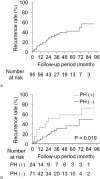Analysis of risk factors for colonic diverticular bleeding and recurrence
- PMID: 28930849
- PMCID: PMC5617716
- DOI: 10.1097/MD.0000000000008090
Analysis of risk factors for colonic diverticular bleeding and recurrence
Abstract
The increase in incidence of colonic diverticular bleeding is relative to an age-related rise in the incidence of colonic diverticulosis and use of antithrombotic medication. However, risk factors related to the onset, recurrence, and prophylaxis have not been established. Therefore, we aimed to determine risk factors for the onset and recurrence of colonic diverticular bleeding.An age- and sex-matched case-control study was performed to assess the risk factors for the onset of colonic diverticular bleeding. The distribution of diverticulosis, comorbidity, and medication were evaluated from medical records. We also assigned patients with a first-time bleeding into groups with and without rebleeding during follow-up to determine risk factors for recurrence.Bilateral colonic diverticulosis, nonselective nonsteroidal anti-inflammatory drugs (NSAIDs), low-dose aspirin (LDA), and anticoagulants were significant risk factors for the onset of colonic diverticular bleeding on multivariate analysis. In contrast, the use of selective cyclooxygenase-2 (COX-2) inhibitor was not a risk factor for the onset. The incidence of bleeding in direct oral anticoagulant and warfarin users was not different between the 2 groups. The cumulative recurrence rate at 1 year was 15%. Recurrence rate was significantly higher in patients with a prior history of colonic diverticular bleeding than those without. Steroid use was associated with recurrence.Extensive distribution of diverticulosis and use of nonselective NSAIDs, LDA, and anticoagulants are regarded as risk factors for the onset of colonic diverticular bleeding. In addition, a prior history of colonic diverticular bleeding is related to the recurrence.
Conflict of interest statement
The authors have no funding and conflicts of interest to disclose.
Figures
Similar articles
-
Colonic diverticular hemorrhage associated with the use of nonsteroidal anti-inflammatory drugs, low-dose aspirin, antiplatelet drugs, and dual therapy.J Gastroenterol Hepatol. 2014 Oct;29(10):1786-93. doi: 10.1111/jgh.12595. J Gastroenterol Hepatol. 2014. PMID: 24720424
-
Assessment of the risk factors for colonic diverticular hemorrhage.Dis Colon Rectum. 2008 Jan;51(1):116-20. doi: 10.1007/s10350-007-9137-8. Epub 2007 Dec 18. Dis Colon Rectum. 2008. PMID: 18085336
-
Risk factors for severity and recurrence of colonic diverticular bleeding.Rev Esp Enferm Dig. 2017 Jan;109(1):3-9. doi: 10.17235/reed.2016.4190/2015. Rev Esp Enferm Dig. 2017. PMID: 27925464
-
Natural history of bleeding risk in colonic diverticulosis.Minerva Gastroenterol Dietol. 2017 Jun;63(2):152-157. doi: 10.23736/S1121-421X.17.02384-4. Epub 2017 Feb 24. Minerva Gastroenterol Dietol. 2017. PMID: 28240003 Review.
-
Recent Trends in Treatment for Colonic Diverticular Bleeding in Japan.Digestion. 2020;101(1):12-17. doi: 10.1159/000504089. Epub 2019 Nov 13. Digestion. 2020. PMID: 31722336 Review.
Cited by
-
Presentation and anatomical distribution of diverticular disease in four hospitals in Sudan.Pan Afr Med J. 2020 Jun 3;36:64. doi: 10.11604/pamj.2020.36.64.22987. eCollection 2020. Pan Afr Med J. 2020. PMID: 32754291 Free PMC article.
-
Segmental Colitis Associated Diverticulosis-A Possible Diagnosis in Teenagers.Front Pediatr. 2018 Jun 5;6:168. doi: 10.3389/fped.2018.00168. eCollection 2018. Front Pediatr. 2018. PMID: 29922640 Free PMC article.
-
Direct Oral Anticoagulant Use and Risk of Diverticular Hemorrhage: A Systematic Review of the Literature.Can J Gastroenterol Hepatol. 2019 Jun 18;2019:9851307. doi: 10.1155/2019/9851307. eCollection 2019. Can J Gastroenterol Hepatol. 2019. PMID: 31316948 Free PMC article.
-
Risk factors for patients hospitalized with recurrent colon diverticular bleeding: a single center experience.Front Med (Lausanne). 2023 Nov 7;10:1195051. doi: 10.3389/fmed.2023.1195051. eCollection 2023. Front Med (Lausanne). 2023. PMID: 38020084 Free PMC article.
-
Effectiveness of Conservative Treatment without Early Colonoscopy in Patients with Colonic Diverticular Hemorrhage.Can J Gastroenterol Hepatol. 2020 Jan 14;2020:3283940. doi: 10.1155/2020/3283940. eCollection 2020. Can J Gastroenterol Hepatol. 2020. PMID: 32399458 Free PMC article.
References
-
- Stollman N, Raskin JB. Diverticular disease of the colon. Lancet 2004;363:631–9. - PubMed
-
- Nagata N, Niikura R, Aoki T, et al. Increase in colonic diverticulosis and diverticular hemorrhage in an aging society: lessons from a 9-year colonoscopic study of 28,192 patients in Japan. Int J Colorectal Dis 2014;29:379–85. - PubMed
-
- Roberts P, Abel M, Rosen L, et al. Practice parameters for sigmoid diverticulitis: The Standards Task Force American Society of Colon and Rectal Surgeons. Dis Colon Rectum 1995;38:125–32. - PubMed
-
- Chia JG, Wilde CC, Ngoi SS, et al. Trends of diverticular disease of the large bowel in a newly developed country. Dis Colon Rectum 1991;34:498–501. - PubMed
MeSH terms
Substances
LinkOut - more resources
Full Text Sources
Other Literature Sources
Medical
Research Materials



